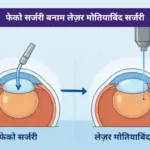Astigmatism is a common refractive error that can cause blurred or distorted vision. It occurs when the cornea or lens of the eye is irregularly shaped, preventing light from focusing correctly on the retina. While glasses and contact lenses are effective solutions, many seek long-term correction through advanced treatments like LASIK. In this blog, we’ll explore the role of LASIK surgery for cylindrical power, its effectiveness, and whether it’s the right choice for you.
What is Astigmatism?
Astigmatism is a refractive error caused by an irregular curvature of the cornea or lens. Cylindrical power is another name for astigmatism. The cornea and lens are symmetrically curved in a perfectly shaped eye, allowing light to focus directly on the retina. In astigmatism, the uneven shape causes light to focus at multiple points, resulting in blurred or distorted vision.
Symptoms of Astigmatism:
- Blurred or distorted vision at all distances.
- Eye strain or discomfort.
- Frequent headaches.
- Difficulty seeing at night.
Astigmatism often coexists with other refractive errors like myopia (nearsightedness) or hyperopia (farsightedness).
Can LASIK Cure Astigmatism?
The answer is yes. LASIK can cure astigmatism in most cases. LASIK (Laser-Assisted In Situ Keratomileusis) is a popular and highly effective refractive surgery that reshapes the cornea to correct vision problems, including astigmatism.
Using a precise laser, LASIK smooths out the irregular curvature of the cornea, allowing light to focus properly on the retina. This eliminates or significantly reduces the effects of astigmatism.
How Does LASIK for Cylindrical Power Work?
LASIK involves the following steps:
- Creating a Corneal Flap: A thin, hinged flap is created on the cornea’s surface using a femtosecond laser.
- Reshaping the Cornea: An excimer laser removes microscopic layers of corneal tissue to correct its shape and address astigmatism.
- Repositioning the Flap: The corneal flap is placed back in position, where it naturally adheres without the need for stitches.
By reshaping the cornea, LASIK eye surgery ensures that light focuses accurately on the retina, improving vision clarity.
Benefits of LASIK for Cylindrical Power
- Reduces or eliminates the need for glasses or contact lenses.
- Provides long-term correction for astigmatism.
- Offers quick recovery with minimal downtime.
Ideal Candidates for LASIK
While LASIK is a highly effective solution for astigmatism, not everyone is a suitable candidate. Here are some factors to consider:
- Age 18 or older with stable vision for at least a year.
- Mild to moderate astigmatism (up to 6 diopters).
- Healthy corneas with sufficient thickness.
- No underlying eye conditions like keratoconus or severe dry eyes.
Who Should Avoid LASIK?
- Individuals with very high cylindrical power beyond the safe limits of LASIK correction.
- Those with corneal scarring or thin corneas.
- Pregnant or breastfeeding individuals, as hormonal changes can affect vision stability.
A comprehensive evaluation by an ophthalmologist can determine your eligibility for LASIK.
Alternatives to LASIK for Astigmatism
If you’re not a candidate for LASIK, other procedures can address cylindrical power and astigmatism.
SMILE (Small Incision Lenticule Extraction)
SMILE is a minimally invasive laser surgery designed to treat myopia and mild astigmatism. Unlike LASIK, it uses a smaller incision, typically 2–4 millimetres, making it less invasive.
How It Works:
A femtosecond laser creates a small lens-shaped piece of tissue (lenticule) in the cornea, which is removed to reshape the cornea and correct refractive errors.
Benefits:
- Reduced risk of dry eyes.
- Faster recovery time.
- Suitable for individuals with thinner corneas.
PRK (Photorefractive Keratectomy)
PRK is a laser-based procedure that doesn’t involve creating a corneal flap, making it ideal for individuals with thin or irregular corneas.
How It Works:
The outer layer of the cornea (epithelium) is removed, and an excimer laser reshapes the cornea. The epithelium naturally regenerates over a few days.
Benefits:
- No flap-related complications.
- Effective for correcting astigmatism and other refractive errors.
- Reliable alternative for those not eligible for LASIK.
Toric Intraocular Lenses (IOLs)
Toric IOLs are specialised lenses implanted during cataract surgery to correct astigmatism while addressing cataracts.
How It Works:
During cataract surgery, the clouded lens is replaced with a toric lens designed to correct the cornea’s irregular shape.
Benefits:
- Dual solution for cataracts and astigmatism.
- Long-term vision correction.
- Ideal for patients ineligible for laser surgery.
Which is Right for You?
Each procedure has unique advantages, and the best option depends on your specific needs, corneal health, and lifestyle. A consultation with an eye specialist can help you determine the most suitable treatment.
Take the first step toward healthier, more beautiful eyes Book an Appointment with Centre for Sight in India!
Frequently Asked Questions
Yes, LASIK provides permanent correction for most cases of astigmatism by reshaping the cornea.
Yes, LASIK effectively treats cylindrical power by addressing the uneven curvature of the cornea.
Yes, LASIK is a safe and FDA-approved procedure with a high success rate for correcting cylindrical power and astigmatism.
The success rate is over 95% for individuals with mild to moderate astigmatism who meet the eligibility criteria.





